September 27, 2010 Updated
MICHIBIKI injected into the quasi-zenith orbit with its center longitude of about 135 degrees
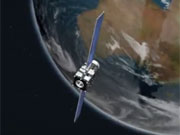 The First Quasi-Zenith Satellite MICHIBIKI, which was launched by the H-IIA Launch Vehicle No. 18 on Sept. 11 (JST,) has been maneuvered to shift its orbit from the drift orbit to the quasi-zenith orbit starting on the 21st. The satellite is now confirmed to be inserted into the quasi-zenith orbit over Japan with its center longitude of about 135 degrees through the final orbit control performed at 6:28 a.m. on Sept. 27.
The First Quasi-Zenith Satellite MICHIBIKI, which was launched by the H-IIA Launch Vehicle No. 18 on Sept. 11 (JST,) has been maneuvered to shift its orbit from the drift orbit to the quasi-zenith orbit starting on the 21st. The satellite is now confirmed to be inserted into the quasi-zenith orbit over Japan with its center longitude of about 135 degrees through the final orbit control performed at 6:28 a.m. on Sept. 27.We will carry out initial functional verification of the satellite including the onboard devices for about three months in cooperation with organizations for technological verifications.
September 19, 2010 Updated
MICHIBIKI shifted to the regular control mode
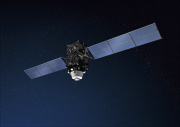 The first quasi-zenith satellite MICHIBIKI, which was launched by the H-IIA Launch Vehicle No. 18 on September 11, was injected into its drift orbit (or the orbit that is one step before getting into the quasi-zenith satellite) after five apogee engine firings. Accordingly, JAXA confirmed that the MICHIBIKI shifted to the regular control mode at 7:31 p.m. on the 19th (JST), thus the critical operation phase has been completed.
The first quasi-zenith satellite MICHIBIKI, which was launched by the H-IIA Launch Vehicle No. 18 on September 11, was injected into its drift orbit (or the orbit that is one step before getting into the quasi-zenith satellite) after five apogee engine firings. Accordingly, JAXA confirmed that the MICHIBIKI shifted to the regular control mode at 7:31 p.m. on the 19th (JST), thus the critical operation phase has been completed.We will take about a week to shift the MICHIBIKI from the drift orbit to the quasi-zenith orbit, and carry out initial functional verification of the onboard devices in cooperation with organizations that perform technological verifications for about three months.
September 18, 2010 Updated
News Flash [11]
First Quasi-Zenith Satellite MICHIBIKI Result of the Drift Orbit Injection (September 17, 2010 Updated
News Flash [10]
First Quasi-Zenith Satellite MICHIBIKI Result of the Fifth Apogee Engine Firing (September 17, 2010 Updated
News Flash [9]
First Quasi-Zenith Satellite MICHIBIKI Orbit Calculation Result and the Fifth Apogee Engine Firing Schedule (September 16, 2010 Updated
News Flash [8]
First Quasi-Zenith Satellite MICHIBIKI Result of the Fourth Apogee Engine Firing (September 16, 2010 Updated
News Flash [7]
First Quasi-Zenith Satellite MICHIBIKI Orbit Calculation Result and the Fourth Apogee Engine Firing Schedule (September 14, 2010 Updated
News Flash [6]
First Quasi-Zenith Satellite MICHIBIKI Result of the Third Apogee Engine Firing (September 14, 2010 Updated
News Flash [5]
First Quasi-Zenith Satellite MICHIBIKI Orbit Calculation Result and the Third Apogee Engine Firing Schedule (September 13, 2010 Updated
News Flash [4]
First Quasi-Zenith Satellite MICHIBIKI Result of the Second Apogee Engine Firing (September 13, 2010 Updated
News Flash [3]
First Quasi-Zenith Satellite MICHIBIKI Orbit Calculation Result of the Second Apogee Engine Firing Schedule (September 12, 2010 Updated
News Flash [2]
First Quasi-Zenith Satellite MICHIBIKI Result of the First Apogee Engine Firing (September 12, 2010 Updated
News Flash [1]
First Quasi-Zenith Satellite MICHIBIKI Orbit Calculation Results and Schedule of the First Apogee Engine Firing (September 11, 2010 Updated
MICHIBIKI successfully launched!!
 The H-IIA Launch Vehicle No. 18 (H-IIA F18) with the first quasi-zenith satellite "MICHIBIKI" onboard was launched at 8:17 p.m. on September 11 (Japan Standard Time) from the Tanegashima Space Center. The H-IIA F18 flew smoothly, and, at 28 minutes and 27 seconds after liftoff, the MICHIBIKI was separated from the H-IIA.
The H-IIA Launch Vehicle No. 18 (H-IIA F18) with the first quasi-zenith satellite "MICHIBIKI" onboard was launched at 8:17 p.m. on September 11 (Japan Standard Time) from the Tanegashima Space Center. The H-IIA F18 flew smoothly, and, at 28 minutes and 27 seconds after liftoff, the MICHIBIKI was separated from the H-IIA.We will update you with the latest information on the MICHIBIKI on the special site.
(Photo: JAXA/Mitsubishi Heavy Industries)
September 2, 2010 Updated
MICHIBIKI live launch report from 7:45 p.m. on Sept. 11th (Sat.)
 JAXA is broadcasting a live report of the H-IIA Launch Vehicle No. 18 launch with the first quasi-zenith satellite MICHIBIKI onboard from 7:45 p.m. on September 11 (Saturday,) 2010 (Japan Standard Time.)
JAXA is broadcasting a live report of the H-IIA Launch Vehicle No. 18 launch with the first quasi-zenith satellite MICHIBIKI onboard from 7:45 p.m. on September 11 (Saturday,) 2010 (Japan Standard Time.)You can watch the report through the Internet and some cell phone services as well as at some JAXA offices, including JAXA i, Tsukuba Space Center, at scientific museums, and street vision locations. Please support the MICHIBIKI launch by watching the dynamic live launch images from the Tanegashima Space Center.
We welcome your support messages to the MICHIBIKI, as the project team awaits its launch. Some of the messages may be introduced during the live launch report.
* Please be aware that the launch live report schedule is subject to change due to the preparation status and weather conditions.
August 31, 2010 Updated
MICHIBIKI transported to the VAB
On August 31, the first quasi-zenith satellite "MICHIBIKI" encapsulated by a fairing was transported to the Vehicle Assembly Building (VAB,) where the H-IIA Launch Vehicle No. 18 was waiting for its payload (left photo.)After moving to the VAB, the encapsulated MICHIBIKI is now slung and loaded onto the launch vehicle. (center and right photos.) It is 11 more days to launch, thus we will be in the very final launch preparation after the loading operations are over.
Left: Arriving at the VAB
Center: Looking up at the sling operations
Right: Loading operations of the encapsulated MICHIBIKI

August 27, 2010 Updated
MICHIBIKI encapsulated in the fairing
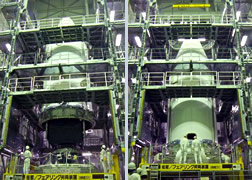 On August 26, the first quasi-zenith satellite "MICHIBIKI" was encapsulated in the fairing at the Spacecraft and Fairing Assembly Building (SFA) at the Tanegashima Space Center (TNSC.) The fairing covers the payload to protect it from air resistance, friction heat, and acoustic vibrations during launch. The fairing for this launch is 4S-type, which is 4 meters in diameter, and 12 meters in height.
On August 26, the first quasi-zenith satellite "MICHIBIKI" was encapsulated in the fairing at the Spacecraft and Fairing Assembly Building (SFA) at the Tanegashima Space Center (TNSC.) The fairing covers the payload to protect it from air resistance, friction heat, and acoustic vibrations during launch. The fairing for this launch is 4S-type, which is 4 meters in diameter, and 12 meters in height.The encapsulated payload will be transported to the Vehicle Assembly Building and loaded on to the H-IIA Launch Vehicle No. 18.
August 26, 2010 Updated
MICHIBIKI mated with the PAF
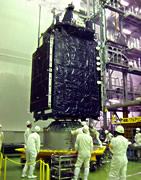 The first quasi-zenith satellite "MICHIBIKI" is now loaded with fuel at the Spacecraft and Fairing Assembly Building (SFA) at the Tanegashima Space Center, and is now in the final preparation phase before launch.
The first quasi-zenith satellite "MICHIBIKI" is now loaded with fuel at the Spacecraft and Fairing Assembly Building (SFA) at the Tanegashima Space Center, and is now in the final preparation phase before launch.On August 24, a joint operation with the launch vehicle provider started, and the MICHIBIKI was mated with the Payload Attach Fitting (PAF) of the launch vehicle, which is a connection part between the payload and the launch vehicle.
The MICHIBIKI will be encapsulated by the payload fairing, then moved to the Vehicle Assembly Building (VAB) to be loaded onto the H-IIA Launch Vehicle No. 18.
August 23, 2010 Updated
MICHIBIKI data publication site 'QZ-Vision' starts full-scale operations
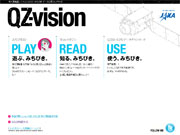 The "QZ-Vision" website for the first quasi-zenith satellite "MICHIBIKI"is now fully open. The site, whose major purpose is to publish data acquired by the MICHIBIKI, consists of three themes, PLAY (to play with MICHIBIKI,) READ (to learn about MICHIBIKI) and USE (to use MICHIBIKI.) The site is designed to be enjoyable both for satellite positioning specialists and novices as it provides not only MICHIBIKI’s operation information but also detailed explanation of the quasi-zenith satellite system, the 3D MICHIBIKI which you can touch and play with, and interviews with leaders in various fields, because "MICHIBIKI" means "to lead" in Japanese.
The "QZ-Vision" website for the first quasi-zenith satellite "MICHIBIKI"is now fully open. The site, whose major purpose is to publish data acquired by the MICHIBIKI, consists of three themes, PLAY (to play with MICHIBIKI,) READ (to learn about MICHIBIKI) and USE (to use MICHIBIKI.) The site is designed to be enjoyable both for satellite positioning specialists and novices as it provides not only MICHIBIKI’s operation information but also detailed explanation of the quasi-zenith satellite system, the 3D MICHIBIKI which you can touch and play with, and interviews with leaders in various fields, because "MICHIBIKI" means "to lead" in Japanese.
August 16, 2010 Updated
Let's support the MICHIBIKI launch with its poster and wallpaper!
 A poster and leaflet informing of the launch of the MICHIBIKI by H-IIA Launch Vehicle No. 18 were released.
A poster and leaflet informing of the launch of the MICHIBIKI by H-IIA Launch Vehicle No. 18 were released.We've also prepared wallpapers and screensaver for PCs.
Let's decorate your working place or school with the poster and put the wallpaper and screensaver on your PC to support the launch on Sep. 11.
- Poster (PDF:2.35MB, Japanese language only)
- Leaflet (PDF:2.8MB, Japanese language only)
- Wallpapers
- Screensaver (QZ-Vision (Project site))
August 10, 2010 Updated
Preview of 'QZ-Vision,' MICHIBIKI data publication site
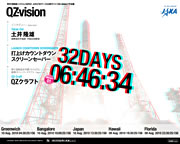 The website "QZ-Vision" for publishing data acquired by the First Quasi-Zenith Satellite "MICHIBIKI" will open on August 23.
The website "QZ-Vision" for publishing data acquired by the First Quasi-Zenith Satellite "MICHIBIKI" will open on August 23.The site will not only provide operation information about the MICHIBIKI after its launch, but also offer detailed explanations about the quasi-zenith satellite system (QZSS) and the 3D MICHIBIKI with which you can touch and play, It will also publish interviews with leading experts in various fields including the famous cartoonist Cyuya Koyama. Both those who have never heard of the QZSS and specialists in the field can enjoy the site.
We are offering a preview of the site prior to its official opening. It currently is publishing an interview with Astronaut Takao Doi, Chief of the Space Application Section, United Nations, Office for Outer Space Affairs, as well as a launch countdown screen saver, and a 1/50th scale super precise paper craft "MICHIBIKI" on the site. Please enjoy them.
August 4, 2010 Updated
MICHIBIKI new launch date decided!
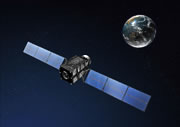 The new launch date of the First Quasi-Zenith Satellite "MICHIBIKI" by the H-IIA Launch Vehicle No. 18 has been set for September 11 (Sat.) The launch time will be between 8:17 and 9:16 p.m.
The new launch date of the First Quasi-Zenith Satellite "MICHIBIKI" by the H-IIA Launch Vehicle No. 18 has been set for September 11 (Sat.) The launch time will be between 8:17 and 9:16 p.m.The launch of the MICHIBIKI was postponed due to a potential concern in the onboard reaction wheels, but the said part was replaced, thus we are ready for the launch.
We welcome your support messages to the MICHIBIKI at its special site. The project team who develops and operates the MICHIBIKI is looking forward to hearing from you.
July 28, 2010 Updated
H-IIA F18 arrives at the TNSC
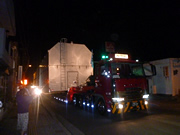 The H-IIA Launch Vehicle No. 18 (H-IIA F18,) which will carry the First Quasi-Zenith Satellite "MICHIBIKI" to space, was transported from Shimama Port on Tanegashima Island to the Tanegashima Space Center (TNSC.)
The H-IIA Launch Vehicle No. 18 (H-IIA F18,) which will carry the First Quasi-Zenith Satellite "MICHIBIKI" to space, was transported from Shimama Port on Tanegashima Island to the Tanegashima Space Center (TNSC.)The first and the second stages of the launch vehicle were in separate containers for transportation, thus they will be assembled at the Vehicle Assembly Building (VAB) at the TNSC.
July 12, 2010 Updated
Support the "MICHIBIKI" with wallpapers
 It is unfortunate that the launch of the MICHIBIKI has been delayed, but its project team and related personnel are working hard to carry out the launch in this summer.
It is unfortunate that the launch of the MICHIBIKI has been delayed, but its project team and related personnel are working hard to carry out the launch in this summer.To cheer them up, we created wallpapers for personal computers.
Please decorate your computer and support the MICHIBIKI project.
June 23, 2010 Updated
MICHIBIKI launch delay
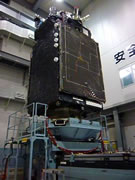 JAXA has been preparing for the launch of the H-IIA Launch Vehicle No.18 with the first Quasi-Zenith Satellite "MICHIBIKI" onboard on August 2, but a potential concern was found in the onboard reaction wheels of the MICHIBIKI. We need time to exchange the parts thus we have to postpone the launch.
JAXA has been preparing for the launch of the H-IIA Launch Vehicle No.18 with the first Quasi-Zenith Satellite "MICHIBIKI" onboard on August 2, but a potential concern was found in the onboard reaction wheels of the MICHIBIKI. We need time to exchange the parts thus we have to postpone the launch.We will announce the new launch day as soon as it is determined.
June 9, 2010 Updated
Launch day of MICHIBIKI decided! Special site opens
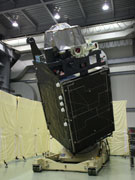 The launch day of the H-IIA Launch Vehicle No. 18 with the first Quasi-Zenith Satellite "MICHIBIKI" onboard was set between 10:54 p.m. and 11:54 p.m. on August 2 (Mon., Japan Standard Time.)
The launch day of the H-IIA Launch Vehicle No. 18 with the first Quasi-Zenith Satellite "MICHIBIKI" onboard was set between 10:54 p.m. and 11:54 p.m. on August 2 (Mon., Japan Standard Time.)We have opened the "MICHIBIKI special site" to provide updated information about MICHIBIKI's preparation and launch status. Please enjoy the site.
We are welcoming your support messages at the special site. We are looking forward to delivering your messages to the MICHIBIKI project team who are in charge of development and operation of the satellite.
